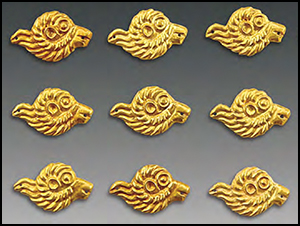Crossref Citations
This article has been cited by the following publications. This list is generated based on data provided by
Crossref.
2018.
ANNUAL BIBLIOGRAPHY.
Early China,
Vol. 41,
Issue. ,
p.
477.
Tan, Panpan
Yang, Junchang
Liu, Yan
Zheng, Yaozheng
and
Yang, Junkai
2020.
Technological characterization of gold jewellery from the Sogdian tomb of Shi Jun (d. 579 CE) in Xi’an, Shaanxi Province.
Scientific Reports,
Vol. 10,
Issue. 1,
Liu, Yan
Li, Rui
Yang, Junchang
Liu, Ruiliang
Zhao, Guoxing
and
Tan, Panpan
2021.
China and the steppe: technological study of precious metalwork from Xigoupan Tomb 2 (4th–3rd c. BCE) in the Ordos region, Inner Mongolia.
Heritage Science,
Vol. 9,
Issue. 1,
Wang, Shengyu
2022.
Exotica, Fashion and Immortality: The New Use of Gold in Han Dynasty China (206bce–ce220).
Cambridge Archaeological Journal,
Vol. 32,
Issue. 3,
p.
345.
Liu, Yan
Xi, Tongyuan
Ma, Jian
Liu, Ruiliang
Kuerban, Reheman
Yan, Feng
Ma, Yingxia
Yu, Jianjun
Ji, Juan
and
Yang, Junchang
2022.
Art historical and archaeometric analyses of the ‘animal style’ gold and silver ornaments (fourth–third centuries bce) found in north‐west China.
Archaeometry,
Vol. 64,
Issue. 3,
p.
671.
Liu, Yan
Xi, Tongyuan
Ma, Jian
Liu, Ruiliang
Kuerban, Reheman
Yan, Feng
Ma, Yingxia
and
Yang, Junchang
2022.
Demystifying ancient filigree art: Microanalytical study of gold earrings from Dongheigou cemetery (4th-2nd century BCE) in north-west China.
Journal of Archaeological Science: Reports,
Vol. 41,
Issue. ,
p.
103344.
Maeir, Aren M.
2023.
“And in Length of Days Understanding” (Job 12:12).
p.
573.
Jiang, Wenqiang
Li, Baozhu
Zhang, Zhen
and
Zhang, Ying
2024.
Hydrochemical Characteristics, Controlling Factors and Groundwater Sources of Zaozigou Gold Mine.
Sustainability,
Vol. 16,
Issue. 18,
p.
7989.
Liu, Yan
Xie, Gaowen
Zhao, Xuyang
Ji, Juan
Lin, James
Liu, Ruiliang
Du, Donglin
and
Yang, Junchang
2025.
Cultural exchange and technical artistry: Gold ornaments found in pre-imperial Qin Tomb at Ta’erpo, Shaanxi.
Archaeological Research in Asia,
Vol. 41,
Issue. ,
p.
100572.
